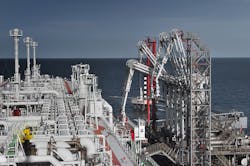Flow Forum Q&A Series: Handling entrained gas in fluid loading and unloading
Flow Business Development
Krohne Inc.
Flow Control‘s inaugural Flow Forum conference will take place May 7-8 at the Westin O’Hare in Chicago. During the event, Steffen Baecker will explore how modern flow measurement technology can be leveraged to ensure continuous accurate measurement — even with high entrained gas conditions — across a wide range of sizes and meter configurations for mobile or fixed installations. Baecker has significant experience with a variety of flow technologies and applications, including stints in manufacturing and as an application engineer working with Coriolis, vortex and variable area instruments. Baecker, who is responsible for business development in Krohne’s flow technology business unit, recently sat down with Flow Control to answer a few questions about some of the key points of discussion he’ll be covering during his Flow Forum presentation.
Why is gas entrainment such a troublesome obstacle for flow measurement systems?
Gas entrainment causes issues for every flow technology. Mechanical meters like turbines will start over-reading with the presence of gas in a liquid application. The reason for that is the higher volume of the gas compared to the liquid. Powered flowmetering technologies face other issues. For example, ultrasonic meters use specific transducers for liquid or gas fluid applications. A liquid ultrasonic meter will have issues caused by the dampening effect of the gas. In Coriolis meters where the measuring tube is vibrated by an oscillator, the effect can be described by using a bouncing basketball example. A bounced air filled basketball will keep bouncing based on conservation of energy principles. However, if that same ball is filled with a little bit of water, it will bounce once and then roll because the liquid absorbs the available energy. The same thing happens to the oscillated tube of a Coriolis meter, causing it to stop performing or working altogether.
What are some common pitfalls end users encounter when it comes to gas entrainment in fluid handling systems?
Gas entrainments cause issues in every industry with all flow technologies. A lot of applications in the food and beverage industry, for example, could never be measured directly because of gas entrainments. Liquid loading and offloading applications also cause a lot of measurement trouble in every industry whenever fluids are moved because of empty hoses at the beginning and blowing out of tanks at the end of the each load.
Can you provide some examples of gas entrainment-related flow measurement failures in hydrocarbon applications?
Inaccurate measurement due to entrained gas can cause huge losses in custody transfer applications, for example. Another good example is the wellhead allocation measurement. If a volume of air is counted as liquid, there is a significant cost and volume mismatch. Accurate measurement during all flow phases can help operators better control their process, optimize production, and manage their flowing inventory value.
How has flow measurement technology evolved in recent years to better handle gas entrainment?
Most meters now recognize a gas entrainment condition better than ever before based on advanced signal processing, but few could actually reliably measure during those conditions. A few of the latest Coriolis meters can now continually operate in very difficult applications independent of the process fluid conditions, Whereas Coriolis meters would stop operating altogether whenever high contents of entrained gas were present, manufacturers have innovated different types of solutions to address these issues in their newest offerings.
Learn More About Flow Forum

